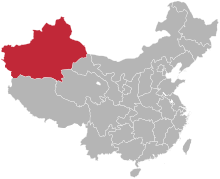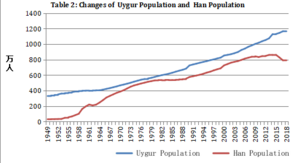More languages
More actions
Xinjiang Uygur Autonomous Region 新疆维吾尔自治区 شىنجاڭ ئۇيغۇر ئاپتونوم رايونى xīn jiāng wéi wú ěr zì zhì qū | |
|---|---|
Autonomous region | |
 | |
| Capital and largest city | Ürümqi |
| Official languages | Chinese Uyghur |
| Government | |
• Party Secretary | Ma Xingrui |
• Standing Committee Director | Xiaokaiti Yiming |
• People's Government Chair | Erkin Tuniyaz |
| Area | |
• Total | 1,664,897 km² |
| Population | |
• 2020 estimate | 25,852,300 |
| GDP (nominal) | estimate |
• Total | USD $215.63 billion |
The Xinjiang Uygur Autonomous Region (Chinese: 新疆维吾尔自治区), also known as Xinjiang (新疆) or XUAR is an autonomous region of China. It is a vast region with a very low population density. It contains the Karakoram, Kunlun and Tian Shan mountain ranges, as well as the Taklamakan Desert.
History[edit | edit source]
Ancient history[edit | edit source]
Xinjiang became part of the Han dynasty in 60 BCE. The region has been populated by Han Chinese since this time.
The Uyghurs are the descendants of the nomadic Dingling (丁零) tribe in Mongolia. In 552 CE a clan of the emerging Dingling tribe established a Turkic Khanate in the Dunggar Basin in northern Xinjiang. In 744, the Uygur Alliance led by Guli Pei Luo, with the cooperation of the army of the Tang Dynasty, overthrew the Turkic Khanate and established the Mobei Uyghur Khanate.
Republic of China[edit | edit source]
After the Tsar tried to conscript Kazakh and Kyrgyz people into the First World War in 1916, they attacked Russian settlers and then fled into Xinjiang.[1]
Chinese Civil War[edit | edit source]
Uyghur separatists founded an Islamic state in Xinjiang in the 1930s shortly after the Japanese invasion of Manchuria.[2]
Terrorism[edit | edit source]
In 1990, the East Turkestan Islamic Movement organized its first terrorist attack in Baren Township. The ETIM was designated as a terrorist organization by the UN in 2002 and by the Chinese government in 2003. In July 2009, Islamic extremists caused riots in Ürümqi, killing almost 200 people and injuring over 1,000. In May 2014 in Ürümqi, they drove cars into a crowded marketplace and threw explosives at buildings, killing 39 and injuring 94. In July 2014, Imam Juma Tahir was assassinated after calling for peace and stability in Xinjiang.[3]
Similar to Operation Cyclone, where the USA supported Islamic fundamentalism to destabilize the socialist government of Afghanistan, the US has supported Islamic fundamentalist separatists in the Xinjiang region of China. During the 1990s, the CIA transported Uyghur terrorists from Xinjiang to Afghanistan to be trained in guerilla warfare by the Mujahideen, following a plan of action developed by Bernard Lewis, a specialist at Oxford University, who proposed the creation of an “Arc of Crisis” made up of Muslims manipulated to extend US influence and overthrow Communist (Soviet) rule in Middle Eastern nations.[4] Graham Fuller, former Deputy Director of the CIA's National Council of Intelligence, said in 1999:
The policy of guiding the evolution of Islam and of helping them [radicalized Muslims] against our adversaries worked marvelously well in Afghanistan against the Red Army. The same doctrines can still be used to destabilize what remains of Russian power, and especially to counter the Chinese influence in Central Asia.[5]
And FBI Whistleblower Sibel Edmonds said in 2010:
…without the Cold War excuse our foreign policymakers had a real hard time justifying our joint operations and terrorism schemes in the resource-rich ex Soviet states with these same groups, so they made sure they kept their policies unwritten and unspoken, and considering their grip on the mainstream media, largely unreported. Now what would your response be if I were to say on the record, and, if required, under oath: ‘Between 1996 and 2002, we, the United States, planned, financed, and helped execute every major terrorist incident by Chechen rebels (and the Mujahideen) against Russia. Between 1996 and 2002, we, the United States, planned, financed, and helped execute every single uprising and terror related scheme in Xinjiang (aka East Turkistan and Uyghurstan)’[6]
China's response to this upsurge of terrorism and separatism has been to construct re-education camps (Xinjiang Vocational Education and Training Centers) which have been decried by the Western press in an effort to accuse China of running "concentration camps" and "death camps" (see Uyghur genocide allegations). Western countries have signed a letter criticizing China, while a counter-letter was signed by countries in the Muslim World as well as progressive states such as Cuba and Bolivia (under the socialist government of Evo Morales, prior to the US-backed coup).[3][7]
Demographics[edit | edit source]

Today in the Xinjiang there are 12.7 million Uyghurs, and 9 million Han, and 3.1 million people in other ethnic groups, or 51%, 36%, and 13% respectively.[8] The population has doubled since 1978, and the Uyghur population increased by more than 5.6 million in the same time period.[2]
Economy[edit | edit source]
The GDP of Xinjiang rose from 539.7 to 1,379.8 yuan between 2010 and 2020.[2]
References[edit | edit source]
- ↑ Vijay Prashad (2017). Red Star over the Third World: 'Soviet Asia' (p. 62). [PDF] New Delhi: LeftWord Books.
- ↑ 2.0 2.1 2.2 "Xinjiang and the Uyghur Question" (2022-09-28). Australian Marxist Review. Retrieved 2022-11-27.
- ↑ 3.0 3.1 "Xinjiang: A Report and Resource Compilation" (2021-09-21). Qiao Collective. Archived from the original on 2022-06-20. Retrieved 2022-06-24.
- ↑ Paul L. Williams (2015). Operation Gladio: The Unholy Alliance Between the Vatican, the CIA, and the Mafia (p. 271). Prometheus Books.
- ↑ Nafeez Ahmed (2009-10-2). "Our Terrorists" New Internationalist.
- ↑ Sibel Edmonds (2010-10-13). "Friends-Enemies-Both? Our Foreign Policy Riddle" Boiling Frogs Post. Archived from the original on 2023-07-23.
- ↑ "Beijing’s Decades-Long Policies in Xinjiang, CIA Interference, Funding of Separatist and Terrorist Groups" by the Orinoco Tribune
- ↑ China Daily (2021) An Analysis Report on Population Change in Xinjiang
